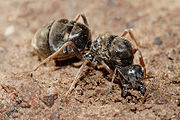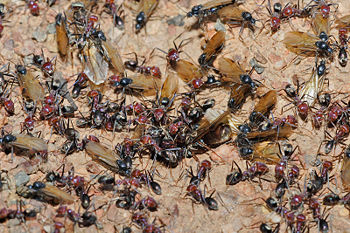
Queen ant
Encyclopedia

Ant
Ants are social insects of the family Formicidae and, along with the related wasps and bees, belong to the order Hymenoptera. Ants evolved from wasp-like ancestors in the mid-Cretaceous period between 110 and 130 million years ago and diversified after the rise of flowering plants. More than...
in an ant colony
Ant colony
An ant colony is an underground lair where ants live, eat and mate. Colonies consist of a series of underground chambers, connected to each other and the surface of the earth by small tunnels. There are rooms for nurseries, food storage, and mating...
; generally she will be the mother of all the other ants in that colony. Some female ants do not need to mate to produce offspring, reproducing through asexual
Asexual reproduction
Asexual reproduction is a mode of reproduction by which offspring arise from a single parent, and inherit the genes of that parent only, it is reproduction which does not involve meiosis, ploidy reduction, or fertilization. A more stringent definition is agamogenesis which is reproduction without...
parthenogenesis
Parthenogenesis
Parthenogenesis is a form of asexual reproduction found in females, where growth and development of embryos occur without fertilization by a male...
or cloning
Cloning
Cloning in biology is the process of producing similar populations of genetically identical individuals that occurs in nature when organisms such as bacteria, insects or plants reproduce asexually. Cloning in biotechnology refers to processes used to create copies of DNA fragments , cells , or...
and all of those offspring will be female.
Ant offspring develop from larvae
Larva
A larva is a distinct juvenile form many animals undergo before metamorphosis into adults. Animals with indirect development such as insects, amphibians, or cnidarians typically have a larval phase of their life cycle...
specially fed in order to become sexually mature among most species. Depending on the species, there can be either a single mother queen, or potentially, hundreds of fertile queens in some species.
Queen ants have the longest life-span of any known insect – up to 28 years in captivity.
Anatomy
The anatomy of a queen ant is very similar to other ants of that particular species, however, they are noticeably larger than the rest of the ants in the colony. As with other antAnt
Ants are social insects of the family Formicidae and, along with the related wasps and bees, belong to the order Hymenoptera. Ants evolved from wasp-like ancestors in the mid-Cretaceous period between 110 and 130 million years ago and diversified after the rise of flowering plants. More than...
s, queens have a hard outer covering called the exoskeleton
Exoskeleton
An exoskeleton is the external skeleton that supports and protects an animal's body, in contrast to the internal skeleton of, for example, a human. In popular usage, some of the larger kinds of exoskeletons are known as "shells". Examples of exoskeleton animals include insects such as grasshoppers...
, and their bodies are divided into three main sections: the head, thorax
Thorax
The thorax is a division of an animal's body that lies between the head and the abdomen.-In tetrapods:...
, and abdomen
Abdomen
In vertebrates such as mammals the abdomen constitutes the part of the body between the thorax and pelvis. The region enclosed by the abdomen is termed the abdominal cavity...
. They have a pair of joint antennae
Antenna (biology)
Antennae in biology have historically been paired appendages used for sensing in arthropods. More recently, the term has also been applied to cilium structures present in most cell types of eukaryotes....
that can be extended forward when investigating an object. Unlike other ants, however, young queens have four wings, i.e. two pair. These are only used for the nuptial flight
Nuptial flight
Nuptial flight is an important phase in the reproduction of most ant, termite and some bee species. During the flight, virgin queens mate with males and then land to start a new colony, or, in the case of honey bees, continue the planned succession of an existing hived colony.- Before the flight :A...
, and are later detached either by the queen herself or chewed off by her worker ants. Moreover, queens and males of most species have both three ocelli, simple bead-like eyes located in the rear central position of the head, additional to their compound eyes.
Development
Ants go through four stages of development: eggEgg (biology)
An egg is an organic vessel in which an embryo first begins to develop. In most birds, reptiles, insects, molluscs, fish, and monotremes, an egg is the zygote, resulting from fertilization of the ovum, which is expelled from the body and permitted to develop outside the body until the developing...
, larva
Larva
A larva is a distinct juvenile form many animals undergo before metamorphosis into adults. Animals with indirect development such as insects, amphibians, or cnidarians typically have a larval phase of their life cycle...
, pupa
Pupa
A pupa is the life stage of some insects undergoing transformation. The pupal stage is found only in holometabolous insects, those that undergo a complete metamorphosis, going through four life stages; embryo, larva, pupa and imago...
(sometimes cocoon, called metamorphosis depending on the species) and adult. The larvae have no legs but are capable of some minor movement, such as bending their head toward a food source when fed. During this stage, the level of care and nourishment the larvae receive will determine their eventual adult form. When resources are low, all larvae will develop into female worker ants; however, if the parent of a sexually reproducing colony has a plentiful supply of food, some of the larvae will receive better nourishment than others, and develop into winged, sexually mature female ants destined to leave the colony.
Early life

Nuptial flight
Nuptial flight is an important phase in the reproduction of most ant, termite and some bee species. During the flight, virgin queens mate with males and then land to start a new colony, or, in the case of honey bees, continue the planned succession of an existing hived colony.- Before the flight :A...
" will leave their parent nest and take flight. The mating flights occur simultaneously in all ant nests of the particular species. The female "queen" ants will fly a long distance, during which they will mate with at least one winged male from another nest. He transfers sperm
Sperm
The term sperm is derived from the Greek word sperma and refers to the male reproductive cells. In the types of sexual reproduction known as anisogamy and oogamy, there is a marked difference in the size of the gametes with the smaller one being termed the "male" or sperm cell...
to the seminal receptacle of the queen and then dies. Once mated, the "queen" will attempt to find a suitable area to start a colony and, once found, detach her wings.
An established colony

Reproduction
Once the colony has established itself, the queen ant will lay eggs continuously. Among those species that reproduce sexually, the queen may choose to fertilize eggs at will by using the sperm cells retained from the nuptial flightNuptial flight
Nuptial flight is an important phase in the reproduction of most ant, termite and some bee species. During the flight, virgin queens mate with males and then land to start a new colony, or, in the case of honey bees, continue the planned succession of an existing hived colony.- Before the flight :A...
, which will create female worker ants instead of males. If the fertilized eggs and pupae are well-nurtured, they could potentially become queens as well. Among ants who do not reproduce sexually, all of the members of the colony are female. The queen ant sires every ant in a colony.
See also
- AntAntAnts are social insects of the family Formicidae and, along with the related wasps and bees, belong to the order Hymenoptera. Ants evolved from wasp-like ancestors in the mid-Cretaceous period between 110 and 130 million years ago and diversified after the rise of flowering plants. More than...
- EusocialityEusocialityEusociality is a term used for the highest level of social organization in a hierarchical classification....
- Ant colonyAnt colonyAn ant colony is an underground lair where ants live, eat and mate. Colonies consist of a series of underground chambers, connected to each other and the surface of the earth by small tunnels. There are rooms for nurseries, food storage, and mating...
- Nuptial flightNuptial flightNuptial flight is an important phase in the reproduction of most ant, termite and some bee species. During the flight, virgin queens mate with males and then land to start a new colony, or, in the case of honey bees, continue the planned succession of an existing hived colony.- Before the flight :A...
- Flying ant day
- Queen beeQueen beeThe term queen bee is typically used to refer to an adult, mated female that lives in a honey bee colony or hive; she is usually the mother of most, if not all, the bees in the hive. The queens are developed from larvae selected by worker bees and specially fed in order to become sexually mature...
External links
- How an Ant Colony starts
- Where to buy or find a Queen Ant
- antbase.org Information on ant species
- Detailed information on ants

